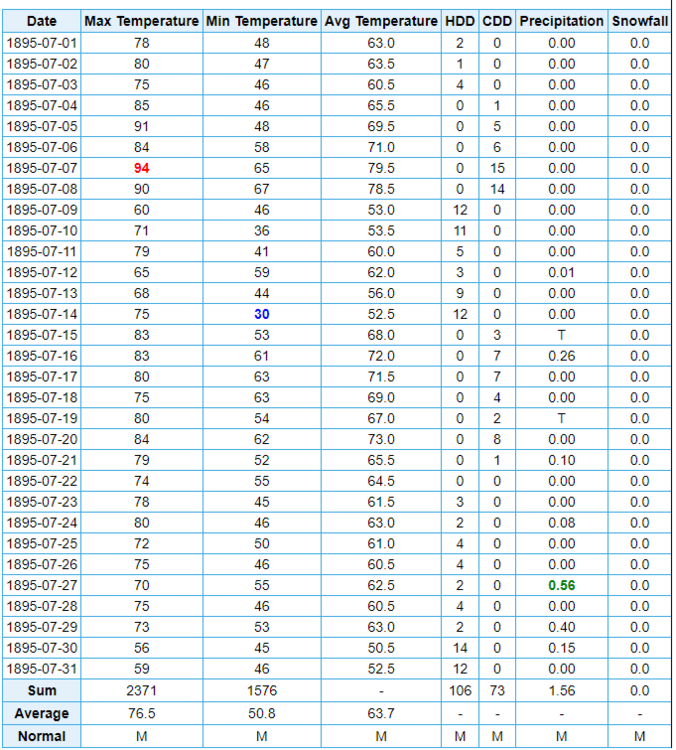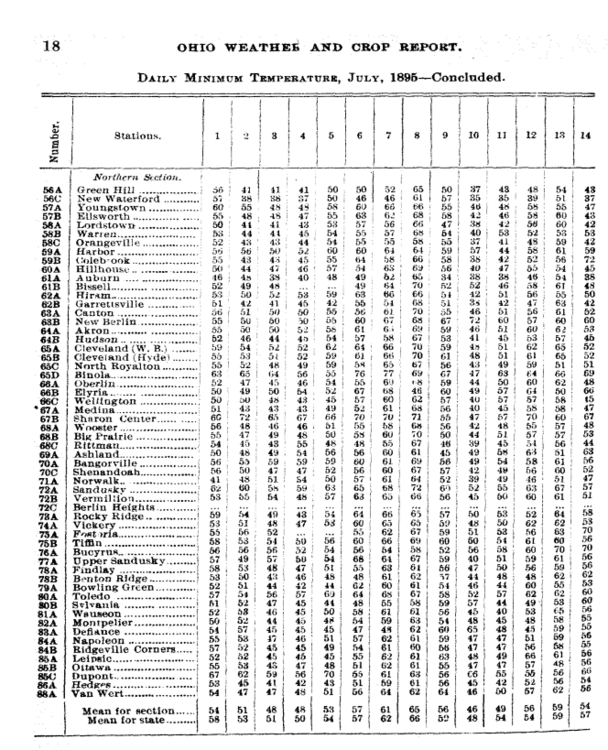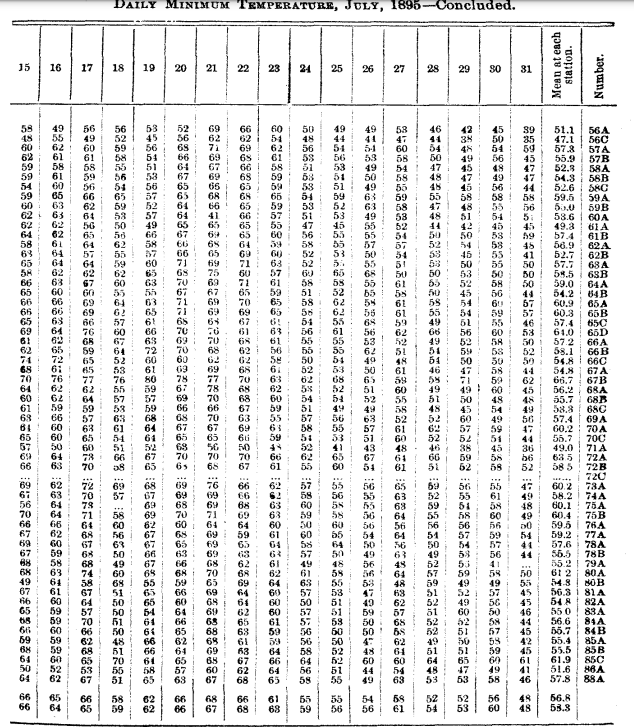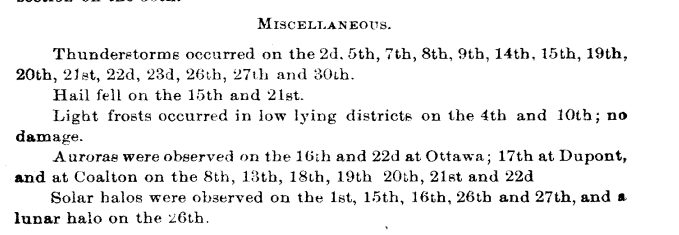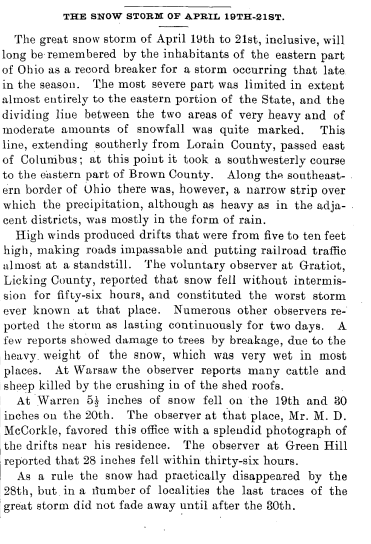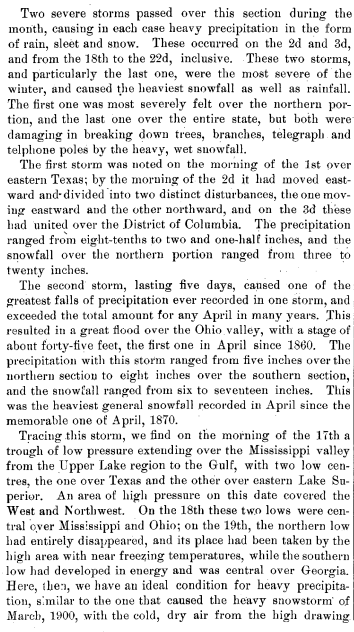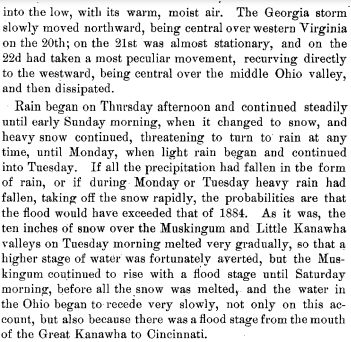
TheClimateChanger
Members-
Posts
1,887 -
Joined
-
Last visited
Content Type
Profiles
Blogs
Forums
American Weather
Media Demo
Store
Gallery
Everything posted by TheClimateChanger
-
Old Crappy Coatesville Snowfall Records!
TheClimateChanger replied to LVwxHistorian's topic in Philadelphia Region
He also appears in the Climatological Data reports for Pennsylvania beginning in March 1888, accessible from NCEI. Those reports also include monthly snowfall, which is not included in those Signal Corps reports. At least in the March 1888 report, they did not include daily temperatures and precipitation. But the reports do identify mean temperature, mean maximum temperature, mean minimum temperature, absolute maxima and minima, mean range, and maximum and minimum daily ranges, as well as precipitation, snowfall, sky conditions, and prevailing wind direction. In March 1888, the mean temperature was reported as 32.3F, with a maximum of 68.5 on the 31st and a minimum of -3 on the 6th. Precipitation totaled 6.28 inches, including 18.5" of snow. Skies were clear on 10 days, fair (partly cloudy) on 12 days, and overcast on 9 days. Prevailing winds were from the west. -
Pittsburgh/Western PA Summer 2022 Discussion
TheClimateChanger replied to Ahoff's topic in Upstate New York/Pennsylvania
Its not going to hold. The clouds and outflow dropped it enough that I’d be shocked if it didn’t drop to 74. The dew point is also down to 65 (as of the top of the hour) so leaves room to drop some more. -
Pittsburgh/Western PA Summer 2022 Discussion
TheClimateChanger replied to Ahoff's topic in Upstate New York/Pennsylvania
Surprised it's not a tornado watch, since the Day 1 outlook has us in the 5% zone. -
Pittsburgh/Western PA Summer 2022 Discussion
TheClimateChanger replied to Ahoff's topic in Upstate New York/Pennsylvania
While today's run of the Euro was oddly cool (apparently expecting more cloud cover), the 00z run looks very hot for next week. -
Pittsburgh/Western PA Summer 2022 Discussion
TheClimateChanger replied to Ahoff's topic in Upstate New York/Pennsylvania
12Z Euro only gets us up to about 84 today. Suffice it to say, that's wrong as it was up to 88 before 1 pm at the airport. -
Spring/Summer 2022 Complaint/Banter Hangout
TheClimateChanger replied to IWXwx's topic in Lakes/Ohio Valley
Yes, looks much drier and it appears there was a drought that summer. Looks like a lot of places had diurnal ranges near or even in excess of 30F. The climate seems much too humid and wet to achieve that today. 1988 was somewhat similar, but much hotter in general. -
Spring/Summer 2022 Complaint/Banter Hangout
TheClimateChanger replied to IWXwx's topic in Lakes/Ohio Valley
I couldn't find the raw data from where this was sourced. Environment Canada has the information uploaded, and also shows a subfreezing low on the 14th (-1.1C). A copy of the original record would probably help, as you'd be able to see whether an error was made in transcription. And the observer might have noted the frost or freeze if it occurred. However, it does not look like Environment Canada has these records readily available for download like NCDC. Looking at surrounding stations, it appears it was a cold morning as there were several reporting lows in the upper 30s to around 40. Not sure if this site was particularly good at radiational cooling, but could be a transcription error (like maybe it was written as 36 or 38, but difficult to decipher). -
Spring/Summer 2022 Complaint/Banter Hangout
TheClimateChanger replied to IWXwx's topic in Lakes/Ohio Valley
-
Spring/Summer 2022 Complaint/Banter Hangout
TheClimateChanger replied to IWXwx's topic in Lakes/Ohio Valley
Looks legitimate to me. I think people underestimate how cold it was in the 1800s. Some of the temperatures would be unfathomable today. This is July 1895 roundup for northern Ohio. New Waterford, Ohio had lows of 38 on the 3rd, 38 on the 4th, 37 on the 5th, 35th on the 10th, 35 on the 11th, 39 on the 12th, 37 on the 14th, 38 on the 29th, and 35 on the 31st. The mean low temperature for the month was 47.1F. It's rare just to fall below 50F these days anywhere in the State of Ohio during July. Having a monthly mean low temperature anywhere in the State of Ohio would be unfathomable. In addition, there were two other sites with mean lows in the 40s... Auburn (49.3F) and Norwalk (49.0F). The coldest low that month was 34F in Auburn on the 9th, but it looks like there low temperatures were shifted forward one day (i.e., the following morning low attributed to the prior day) as that reading is in line with the lows on the 10th, where there widespread low to mid 40s and several 30s. Frosts were recorded on the 4th and 10th that month in parts of the State. -
94F, with a heat index of 107F at Dayton, after a high of 91F yesterday. Looks like a couple more days in the mid 90s this week, with heat indices well in excess of 100F at times.
-
Pittsburgh/Western PA Summer 2022 Discussion
TheClimateChanger replied to Ahoff's topic in Upstate New York/Pennsylvania
It's coming. Heat index up to 113F at the John Glenn International Airport in Columbus, Ohio. Crazy gradient there in central and southeast Ohio along I-70. The current heat index in Zanesville, Ohio, 50 minutes from the airport, is 80F. -
Pittsburgh/Western PA Summer 2022 Discussion
TheClimateChanger replied to Ahoff's topic in Upstate New York/Pennsylvania
Just to illustrate this. The KPIT ASOS is at 40.5N, 80.27W. Here's the temperature at that gridpoint when it's printing the 97 in Pittsburgh. -
Pittsburgh/Western PA Summer 2022 Discussion
TheClimateChanger replied to Ahoff's topic in Upstate New York/Pennsylvania
One thing to keep in mind is the HRRR is a mesoscale model, so it's designed to take into account small features like elevation changes and urbanization. The 97 shown on the Pivotal maps is centered on downtown. Looks to top out around 94 at the airport, where official records are kept. That's not too unreasonable for a high end estimate, but probably more like 90 or 91, maybe 92, given model consensus. -
Pittsburgh/Western PA Summer 2022 Discussion
TheClimateChanger replied to Ahoff's topic in Upstate New York/Pennsylvania
8:00 A.M. EDT / 7:00 A.M. EST. Probably should have shown the prior map at 9Z (5:00 A.M. EDT/4:00 A.M. EST) for a pre-sunrise reading. It was about the same (82F in Pittsburgh). -
Pittsburgh/Western PA Summer 2022 Discussion
TheClimateChanger replied to Ahoff's topic in Upstate New York/Pennsylvania
For context, here are the record warm minimums at Pittsburgh. Every single one of them is from the old downtown station, with the exception of the 78 degree low on July 17, 1990. Of course, if the above map came to fruition, it almost certainly would not hold because there would likely be a rain-cooled low well below that the following evening. Even in the absence of rain, it probably would cool below those levels by 1:00 a.m. EDT. This almost always happens in these situations, but even so I can't ever recall 80+ here in the morning. Usually, its like 75-77 type morning lows that fall to lows in the upper 60s/low 70s due to rain or a cool front passage later in the day. 82 Jul 1, 1901 81 Aug 6, 1918 80 Jul 21, 1930 79 Jul 28, 1901 79 Aug 5, 1918 79 Jul 20, 1930 79 Jul 25, 1934 79 Jul 28, 1901 78 Jun 20, 1924 78 Jul 6, 1911 78 Jul 10, 1881 78 Jul 17, 1990 78 Jul 18, 1887 78 Jul 26, 1892 78 Jul 27 1876 -
Pittsburgh/Western PA Summer 2022 Discussion
TheClimateChanger replied to Ahoff's topic in Upstate New York/Pennsylvania
This would be crazy warm for 12Z. NAM shows mid 90s late Wednesday afternoon ahead of this, but I thought the forecast overnight temperatures Thursday morning were actually more noteworthy... -
Pittsburgh/Western PA Summer 2022 Discussion
TheClimateChanger replied to Ahoff's topic in Upstate New York/Pennsylvania
I don't know. NWS PBZ seeing the potential for a "few 90 degree days" middle of next week. .LONG TERM /MONDAY THROUGH THURSDAY/... A pattern shift is then expected next week as persistent upper troughing eventually fills via an amplifying ridge across the southeastern CONUS. Long range solutions indicate potential for 500mb heights ranging between 590-594 dam, which implies the potential for a few 90 degree days by mid week. Meanwhile, with the forecast area on the northern edge of this building ridge, within continued, nwly flow aloft, unsettled conditions should remain possible through at least mid-week with ongoing chances for showers and thunderstorms. -
If it reaches 90 or better tomorrow or Saturday, it would be the fifth earliest year to reach 90+ since records have been kept at KPIT (i.e., dating back to 1953 - records moved to KPIT in September 1952 when the airport opened). Note: Not necessarily fifth earliest reading, since some of the 4 years with earlier 90+ readings may have had more than one such reading (in fact, I know that's the case for 1962). Should it reach 91 or better, that would be the second earliest such reading. All of the other early 90 degree readings at KPIT were exactly 90 degrees. The only earlier 91+ reading at KPIT was May 18, 1962. Now, in the off chance it were to reach 92 or better, that would be the first time it's ever been that hot anytime in the month of May at the airport site. Currently, the hottest May reading at KPIT is 91, which was reached once in 1962, 1987, 2011, 2012 and 2018.
-
Looks like it's going to be another tough summer for 90s. I noticed the NWS tweeted the temperature at their office was 82 at 1:49 p.m. The 5-minute average temperature at KPIT at 1:51 p.m., basically centered on the point measurement shared by the NWS, was 80F. I wouldn't expect the NWS office to be two degrees warmer than the airport, being just about a mile away at similar elevation in a shady suburban neighborhood versus an open airport site loaded with asphalt tarmac. Most of our 90s are like 90, 91, so if the ASOS is running a couple degrees too cool, I'd expect a lot of days topping out at 88 or 89 again. Hard to reach 90 if the actually air temperature needs to reach 92 to register that number.
-
On this date in 1901, the upper Ohio Valley was in the midst of one of the worst, if not the worst snowstorms, on record for the region with storm totals as high as 3 1/2 feet reported in Stark and Licking Counties. Due to the heavy weight of the snow, structural collapses were reported, rail traffic was brought to a standstill and telegraph lines were downed all over the place. The following passages describe the storm - the first from the Ohio Weather Bureau report, and the second from the West Virginia report for context on the storm. Appears northern and southern stream energy phased into a strong storm over Georgia, which tracked slowly north in to western Virginia but ran into a ridge of high pressure and stalled for most of the day, before becoming completely cut off from the flow, retrograding westward into the Ohio Valley, eventually filling and dissipating. There must have been a strong atmospheric river directed from the Atlantic through Pennsylvania and into Ohio and West Virginia and southern New York based on the widespread 3-8" precipitation totals. While the precipitation fell as a cold rain in Pittsburgh, the river crest was one of the top five of the 20th century and unlikely to be exceeded due to flood control measures put in place after the devastating flooding in March 1936. 1901 is the snowiest April on record in Pittsburgh with 13.5" but that was from the earlier storm from the 2nd to 3rd noted in the West Virginia summary. That storm also produced up to 20 or more inches of snow in the higher elevations.
-
Western PA/Pittsburgh Winter 2021/22 Discussion
TheClimateChanger replied to meatwad's topic in Upstate New York/Pennsylvania
This is going to be another cold rain in the 30s, while central and northeast PA get clobbered, isn't it?



